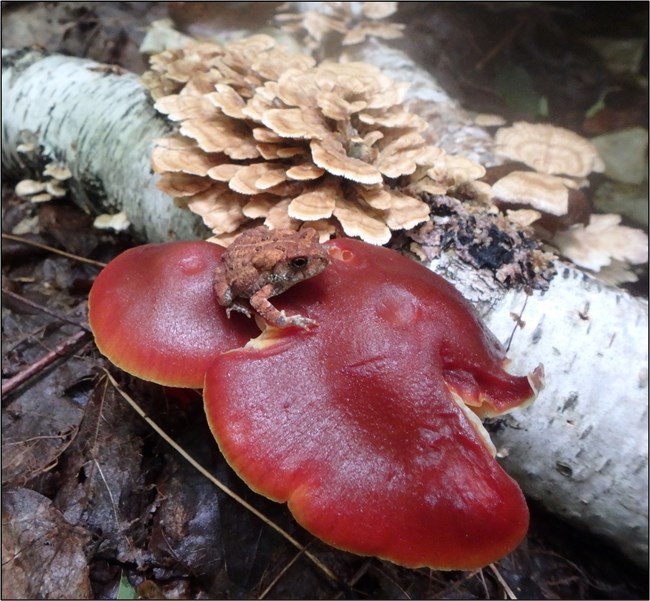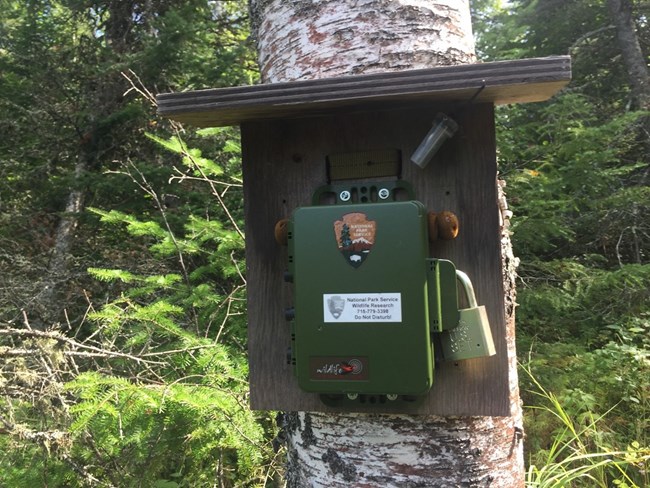Last updated: February 16, 2024
Article
Amphibian Monitoring in the Apostle Islands, 2014-2019

Gary Casper
Eight species of frogs and toad are found in the Apostle Islands:
- Cope’s Gray Treefrog (Hyla chrysoscelis),
- Eastern American Toad (Anaxyrus americanus americanus),
- Gray Treefrog (Hyla versicolor),
- Green Frog (Lithobates clamitans),
- Mink Frog (Lithobates septentrionalis),
- Northern Leopard Frog (Lithobates pipiens),
- Spring Peeper (Pseudacris crucifer), and
- Wood Frog (Lithobates sylvaticus).
Two others: the Boreal Chorus Frog (Pseudacris maculata) and American Bullfrog (Lithobates catesbeianus) are known to occur outside park boundaries but they appear to be absent within the park.
Toads and frogs are unique among amphibians in that they produce calls that are unique and identifiable. This makes it possible to monitor their populations using remote recorders, or “frog loggers.” Monitoring is important for many reasons, the top one being that declines of amphibian populations are one of the most prominent conservation issues in the world. Most amphibians need both land and water during their lifetimes, so they are sensitive to environmental changes including temperature, precipitation, and humidity, making them indicators of climate and habitat change.

NPS
Frog Loggers
Ten permanent amphibian monitoring sites were established in the Apostle Islands in 2014. In April, an audio recorder at each site begins collecting 5-minute samples once an hour between 5:00 p.m. and 3:00 a.m. each day. Four extra samples are collected on the half-hour mark in the evenings between 7:30 and 10:30 p.m. A temperature sensor records temperature once an hour.
Recording frog and toad calls allows us to determine occupancy and abundance. Occupancy is a measure of whether or not a site is occupied by a species. Abundance is tracked by assessing how the maximum call intensity changes on sites across years, and by how many times we hear that species across years. In 2018, we also began tracking phenology, or the trends in annual first-calling dates for each species over time. For now, we are only tracking phenology for three species common to all parks in the network: Eastern American Toads, Green Frogs, and treefrogs. The Gray Treefrog and Cope’s Gray Treefrog have very similar calls that are difficult to distinguish, even with recordings, so for phenology purposes, we combine data for both species.
A sub-sample of the recordings are used to assign a Call Index Value (CIV) to each species. CIV is the maximum call intensity, ranging from CIV=1 (non-overlapping calls indicating few singing males) to CIV= 3 (calls too numerous to count individuals). CIVs can be analyzed over time to determine if a species is increasing or decreasing in abundance.
The Latest (as of 2019)
Six of the Apostle Islands’s eight species of frogs and toads were recorded, with Green Frog and Spring Peeper occurring at every recording site. Mink Frogs were only heard at Stockton and Michigan Island lagoons in 2019, though they are known to be on Long Island and at the Sand River estuary. No Cope’s Gray Treefrogs were heard, nor were any Northern Leopard Frogs detected in 2019, though the leopard frog is known to be on Long Island, and there are unconfirmed reports from Bear, Devils, Stockton, and York Islands. American Bullfrog, Boreal Chorus Frog, and Pickerel Frog were not detected, but none of these three are known to occur at APIS despite several unconfirmed reports.
Phenology
Frogs begin calling earlier at more southerly parks and later at the northern parks, with APIS start-dates falling in the middle of this range. Eastern American Toads were the first to begin calling, with their trills heard on 15 May at the two mainland sites. Green Frogs were next, starting in the last week of May at Stockton, Sand-west, and Basswood Islands. The first treefrogs joined the chorus in the second week of June at the mainland sites, Presque Isle lagoon, and Sand Island-west.
Call Index Values
Several sites and species never exceeded a CIV of 1 in 2019, indicating that few males were present and calling (e.g., Eastern American Toad and Gray Treefrog at both Stockton Island sites). Conversely, Green Frog on Outer Island and Spring Peeper at most sites reached a maximum CIV of 3, indicating large populations at those locations.

What's Next?
The automated recorders continue to turn on each spring and capture the sounds of frogs and toads coming out of their winter slumber and looking for mates. Data collected since 2019 are being analyzed and we will publish regular updates on the status of Apostle Islands amphibians.
